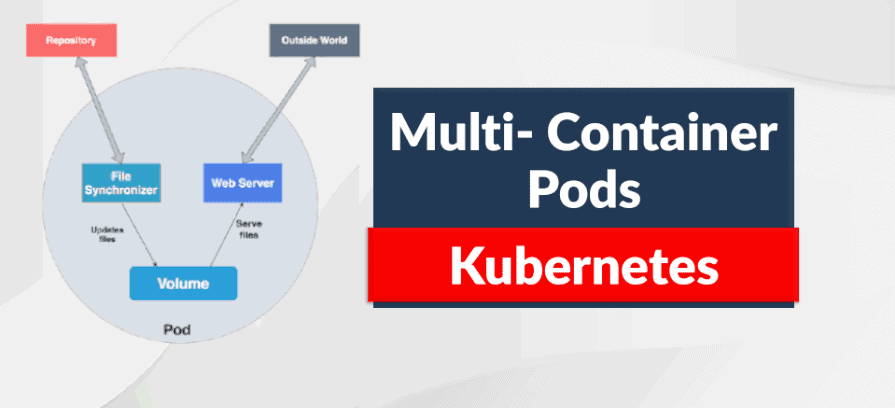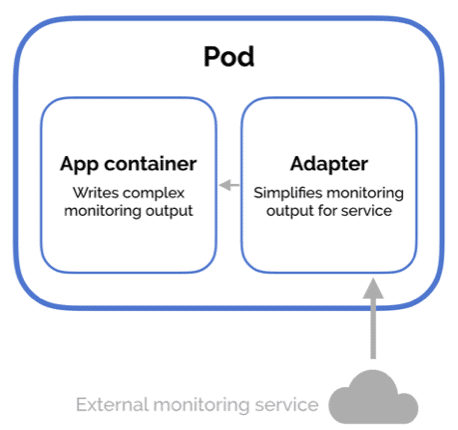Multi Container Pods In Kubernetes - Design Patterns
 Navya A
Navya A
Side-car container || Adapter container || Ambassador container || Init container
Kubernetes, the popular container orchestration platform, provides a robust and flexible environment for deploying and managing containerized applications. One of the powerful features Kubernetes offers is the ability to run multiple containers within the same pod. This concept of multi-container pods opens up a world of possibilities for enhancing the functionality, scalability, and manageability of your applications. In this blog post, we'll explore multi-container pods in Kubernetes, various design patterns, and best practices.
Types of pods:
Pods are the smallest unit that can be deployed and managed by Kubernetes. The two types of Pods are Single Container Pods & Multi Container Pods Kubernetes.
Why Multi-Container Pods?
Before diving into the patterns and practices, let's understand why you might want to run multiple containers within a single pod:
1. Separation of Concerns
Running multiple containers allows you to separate concerns within your application. Each container can focus on a specific task or functionality, making your application easier to maintain and scale.
2. Shared Network Namespace
Containers within the same pod share the same network namespace, meaning they can communicate with each other using localhost. This simplifies inter-container communication.
3. Shared Storage Volumes
Multi-container pods can share storage volumes, facilitating data sharing and synchronization between containers.
4. Sidecar Tasks
You can use sidecar containers to perform auxiliary tasks such as logging, monitoring, or data transformation alongside your main application.
Now that we understand the advantages, let's explore some common design patterns for multi-container pods:
Design Patterns for Multi-Container Pods:
1. Sidecar Pattern
The Sidecar Pattern involves running a secondary container (the sidecar) alongside the main application container. The sidecar container enhances or extends the functionality of the main application. For example, it can collect logs, scrape metrics, or handle security-related tasks.
Example: Imagine a web application where the main container serves web pages, and a sidecar container collects and forwards logs to a central logging system.
2. Adapter Pattern

The Adapter Pattern involves using an adapter container to modify or adapt data or communication between the main application and external systems. It's particularly useful when the main application doesn't natively support a required protocol or format.
Example: You have a main application that communicates with an external API over HTTP, but the API requires data to be sent in a specific format or encrypted. You can use an adapter container to handle the data transformation or encryption.
3. Ambassador Pattern
The Ambassador Pattern employs a secondary container (the ambassador) to abstract complex network operations or interactions with external services from the main application. This pattern is valuable for tasks like SSL termination, load balancing, or protocol translation.
Example: Your main application communicates with external services over HTTPS, but it doesn't handle SSL/TLS encryption. An ambassador container can handle SSL termination, forwarding unencrypted traffic to the main application.
4. Init Container Pattern

The Init Container Pattern involves using one or more init containers to perform setup or initialization tasks before the main application container starts. These init containers run sequentially, and their purpose is to prepare the environment for the main application.
Example: An init container populates a shared volume with configuration files before the main application starts, ensuring that the configuration is in place.
Conclusion:
Multi-container pods in Kubernetes offer flexibility and improved manageability for complex applications. By leveraging design patterns such as the Sidecar, Adapter, Ambassador, Init Container, and Batch Job patterns, you can streamline your containerized workflows and make your applications more robust.
When using multi-container pods, remember to follow best practices, allocate resources appropriately, and maintain a clear separation of concerns. With these guidelines in mind, you can harness the full power of Kubernetes to deploy and manage your containerized applications effectively.
As Kubernetes continues to evolve, multi-container pods remain a valuable tool in your container orchestration toolbox, enabling you to build resilient, scalable, and efficient applications.
Happy containerizing!
Subscribe to my newsletter
Read articles from Navya A directly inside your inbox. Subscribe to the newsletter, and don't miss out.
Written by

Navya A
Navya A
👋 Welcome to my Hashnode profile! I'm a passionate technologist with expertise in AWS, DevOps, Kubernetes, Terraform, Datree, and various cloud technologies. Here's a glimpse into what I bring to the table: 🌟 Cloud Aficionado: I thrive in the world of cloud technologies, particularly AWS. From architecting scalable infrastructure to optimizing cost efficiency, I love diving deep into the AWS ecosystem and crafting robust solutions. 🚀 DevOps Champion: As a DevOps enthusiast, I embrace the culture of collaboration and continuous improvement. I specialize in streamlining development workflows, implementing CI/CD pipelines, and automating infrastructure deployment using modern tools like Kubernetes. ⛵ Kubernetes Navigator: Navigating the seas of containerization is my forte. With a solid grasp on Kubernetes, I orchestrate containerized applications, manage deployments, and ensure seamless scalability while maximizing resource utilization. 🏗️ Terraform Magician: Building infrastructure as code is where I excel. With Terraform, I conjure up infrastructure blueprints, define infrastructure-as-code, and provision resources across multiple cloud platforms, ensuring consistent and reproducible deployments. 🌳 Datree Guardian: In my quest for secure and compliant code, I leverage Datree to enforce best practices and prevent misconfigurations. I'm passionate about maintaining code quality, security, and reliability in every project I undertake. 🌐 Cloud Explorer: The ever-evolving cloud landscape fascinates me, and I'm constantly exploring new technologies and trends. From serverless architectures to big data analytics, I'm eager to stay ahead of the curve and help you harness the full potential of the cloud. Whether you need assistance in designing scalable architectures, optimizing your infrastructure, or enhancing your DevOps practices, I'm here to collaborate and share my knowledge. Let's embark on a journey together, where we leverage cutting-edge technologies to build robust and efficient solutions in the cloud! 🚀💻
